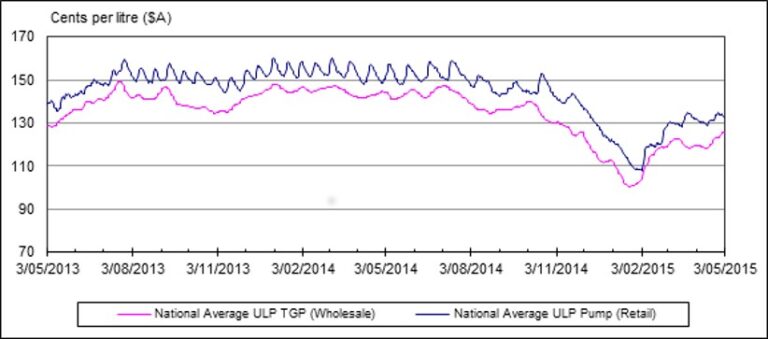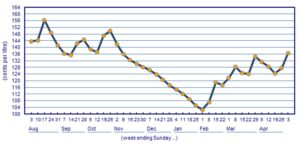Do you remember ten years ago when petrol was only $1 per litre? Or do you remember earlier this year when it dropped below a dollar? No? Well it wasn’t there for long and if your tank was full at the time you may have missed the bargin of the year.
Since January all the key influencers of pump prices (crude oil, exchange rate, refiner margin) have remained stable but the actual pump prices have continued to rise.
The graph below from the Australian Institute of Petroleum shows average weekly pump prices for the 40 weeks to Sunday 3rd May 2015 in Melbourne. There is no doubt we are paying less for fuel that in August 2014 but according to data available from International Energy Agency Oil Market Report the price of crude oil has halved.
Geoff Trotter, general manager Fueltrac, says the discount cycle game that retailers normally play has stopped and consumers are suffering with higher prices.
“Price competition in most metro markets except South Australia has almost disappeared. Adelaide has consistently had a lower average ULP pump price because of the large independent retailer On the Run” says Trotter. “It appears they have chosen to use discount fuel as the carrot to get consumers in their convenience stores which is the model 7 Eleven have used successfully for many years”.
For fleets retail pump prices have a big impact on running costs because most fuel card deals are based on a discount off the pump price. This method is transparent and easy to understand but may not be the best deal in the current environment.
Another fuel card pricing method that was popular ten years ago was Card or Rack Price. This was linked to the terminal gate price (TGP) and is still a method favoured by large fleets and bulk diesel customers . In the current market, with no discount cycle, the gap between TGP and pump price has widen so the Card Price methodology would probably deliver a lower price.
It has gone below one dollar per litre once already this year so its not impossible. If it does, let’s hope it stays there long enough to get a full tank of fuel in at least half the fleet.







